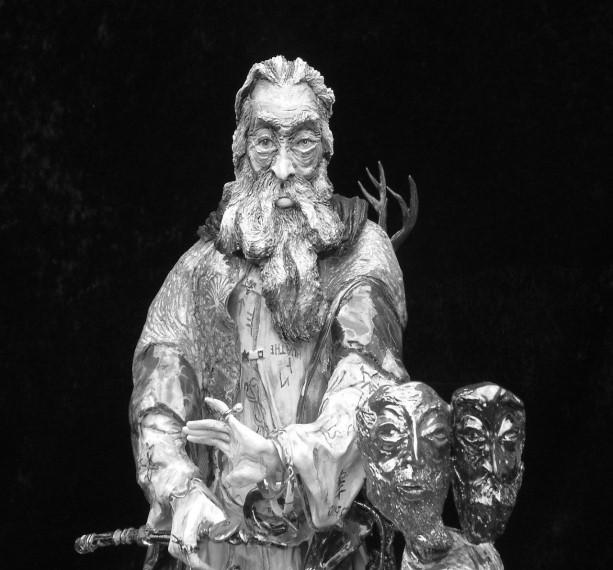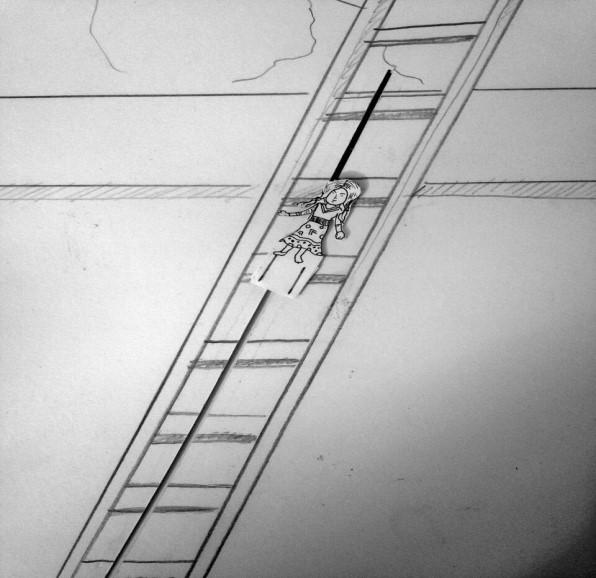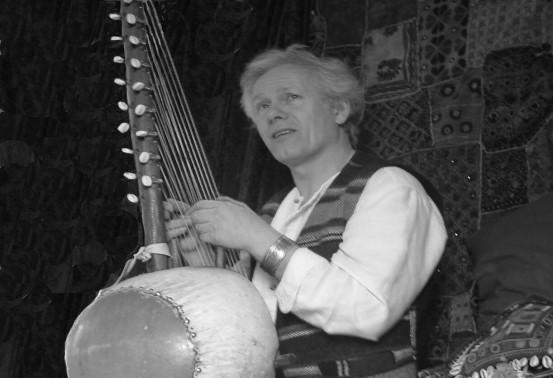
11 minute read
Paul Jackson
Storylines Volume VI Issue 1
Paul Jackson The Artist ’s Way
Advertisement
A chance encounter forges a new strand of creativity that binds all together
‘The Boy was born blind. But he was lucky, his parents loved him; they became his eyes, so, in a way he could see.’
So goes the beginning of one of my favourite stories… But when the boy’s parents are killed in an accident he has to go and live with his grand-
mother, who does not want him. Dilemma. Stories are full of dilemma. But they are also blessed with wisdom. For 40 years I have travelled the journey of the Artist. This has been my living, my breathing, my way of life. For twenty three of those, I have walked the path of the storyteller too, criss~crossing the landscapes between paint and words, clay and voice. They are not so far apart, these creative houses. One day you’re studying Da Vinci, then it’s Vasilisa the beautiful, or Baba Yaga the boney legs.
During the day I might be making the face of Akanidi in porcelain~ smoothing her face to receive a glaze, but that night, she might step out from my tongue in a telling, as she escorts herds of reindeer across an invisible stage covered in invisible snow. Are we not blessed as storytellers to make such marvels come to life in the minds of others?
16
Storylines Volume VI Issue 1
Storytelling came along for me because I needed it. I really needed it. And when you need something that much, it will come along. board. The only place I was able to excel was in the art room. After working as a window display artist, I managed to secure a place at Art College.
I found much solace in Ruth Sawyer who reassures the reader in her beautiful book; The Art of the Storyteller, that Storytelling is a living thing. Not intellectual. That we discover story first through the journey of the heart not the mind.
Merlin
I was not good at school, dyslexia clouding the view of the blackI had been drawing detailed illustrations and making sculptures in porcelain since 1977. The subject matter was of fantasy and Faerie, and the stories of my characters were all in my head. In 1979 I was lucky enough to get my work in front of the Chief Editor of Pan books, David Larkin. He granted me a rare interview and told me that he loved my illustrations and sculptures and advised that if I could develop my writing to the standard of my artwork, I would never be out of a job. So I set to work on my stories, but I found the writing beyond me. The dyslexia unravelled the notion. I tried for a couple of years, failed
17
Storylines Volume VI Issue 1 again and eventually put the writing away. pointed out in his kindest voice, the difference between
By 1990 I had my own studio in Norfolk. there were prestigious
remembering a story and telling a story, making it clear that I was doing the former, not the latter. Having been advised to try out a storytelling course for beginners at St Donats, I found myself at the end of a week of workshops, enthralled, spellbound; my imagination fully engaged, engine
running. When I declared that I was now a Storyteller however, Pomm Clayton, my Tutor raised her eyebrows at me “If you really want to become a storyteller” she said,
exhibitions in London, and collectors increasingly wanted to know what the stories were that informed the pieces. But my experience of writing had not been a good one. I hit upon the idea of Storytelling? Perhaps I could do that instead?
So I advertised my annual open studio exhibition to feature the stories behind the pieces in what I called a Storytelling. I was petrified beyond belief, and that was compounded by the Green Man KS3

unexpected appearance in the audience of Hugh Lupton who lived locally. An invitation to ‘come and have a chat’ was given afterwards and over a cup of tea a few days later, Hugh “start in schools”.
18
Storylines Volume VI Issue 1
So that’s what I did. For two years with one story! Lazy Jack became my anthem and my medicine as I blended the Artist with the Storyteller. I went from one primary school to another ~ 15 the first year, 50 the second. I designed an array of art projects for each Key Stage and eventually for every year group. I learnt very quickly; I had to.
Having 30 kids queuing up for help every session kept me on the golden ball. I learnt how to design storyboards, make animal masks, create 8ft giants and 12 foot totem poles! There were fullsize trees made from recycled card with fruit and flower shapes. Every child drew their closest friend and put that face in the tree inside those shapes to create a Community Tree! I introduced art technology with endless moving bits, spinners, flaps, slits and so on. We would use a wax-resist process called ‘Brusho’ which gave the most stunning visual effects, particularly effective on masks. For some school visits there would be over 300 masks to create ~ elephants, monkeys, kings, lions and many more. I would spend days making templates, drawing & cutting out the basic masks. The children would then individualise them with colour and expression. I would cut, pull and staple and bring them around their faces. I stapled a few children to their masks, but it didn't seem to matter too much!

19
Storylines Volume VI Issue 1
With art technology I would only work with Yr 5 & 6. Just two
I started to introduce more and more stories in the classroom. classes ~ heaven! As I gained in This was about 2003. The sessions confidence, I began to tell stories

to provide imagery to work with. Children would pair up, discuss and agree on a favourite became intense. The art that grew from those sessions had much more substance and meaning. We would explore traditions like the false face society, and their reasons for mask-making and wearing. I felt drawn to find instruments; it was love at first sight with my beloved Kora and along with my Tibetan Singing Bowls they began to find a comfortable place inside
part of the story which they would then bring to life with their moving picture. At the end of a day of story and artwork all the pupils and staff would pile into the hall with their creations. It was such a huge buzz. We would usually finish with an Assembly story and song. my stories.
About a year later, visiting a Care Home, I came across a lady who would not join in with the story-
telling in the lounge. She stayed in her room. A photo was found of her playing a violin, which was amongst her possessions when she had arrived.
20
Storylines Volume VI Issue 1
She would not talk about the violin to the staff. cried a little then, but after a while she smiled.
So on my next visit I was asked if I might go and play my Kora for her. She was laying on her bed, silent. When I returned to the home the next time, she had passed away. There’s a back-story of course. Some distant niece was
I sat at the far end of that bed and contacted through papers found
played for her, quietly allowing us to share something without and her story came to life. It turned out the old lady was once
words. ‘Heart felt’ as Ruth Sawyer might say. It was simple yet, after a brilliant violinist, but age and infirmity had brought an end to
a while we found a gentle her performing. Her parents had
dialogue took root between us, a small conversation about playing, died and she, unmarried, drifted slowly into old age, living alone.
of notes and resonance, and Her voice ~ the violin, silent and
somewhere there I asked her locked away for years.
about her love of the violin, of the photo, of playing and soon, God knows when, but soon, the violin was placed across her body, and I watched as she ran her fingers along the strings, felt the shape and form of something that had once been so familiar to her. She It seems to me that our lives are scattered with chance encounters where a great gift can be shared with a heart connection. One of the most important things that I learnt from her was that story doesn't have to be
21
Storylines Volume VI Issue 1 some complete, fashioned thing Our brief was to go beyond the for it to have power and resonance. All stories matter. dry words of Tacitus, the Roman chronicler and try to uncover the
Suddenly I knew that what I felt in human story of Boudica’s revolt. Maureen and I decided to
her story was what I wanted to feel in every story that I told. I realised that the barrier between myself and others had vanished overnight, and that it was the spiritual and emotional content of story that really mattered. Of course many things will make a gripping story believable and enjoyable, but it will come to naught if the story does not begin from the heart. explore the most important sites of the rebellion; the Menai Straits, Colchester, Anglesey and first, the rising ground at Caister St Edmund, Norfolk. This overlooks the grassy mounds of a Romanised Celtic market, just outside the city of Norwich. Here we recalled the story to one another, feeling the atmosphere. It wasn’t difficult to soon hear the voice of this extraordinary woman calling 100,000 people to
Over the years I have been lucky enough to blend art forms war.
together in many collaborations. In a project on Boudica, Historian Maureen James and I travelled to Ten primary schools were involved in the project. I was commissioned to break the
some of the most important sites of the revolt against Rome in AD 61. revolt down into five story sections, write songs for the two opposing armies, and draw
22
Storylines Volume VI Issue 1
images of the Protagonists in battle. Each day we met in a school and a second school would arrive by coach. The children were asked to choose to be Romans or Celts and I would tell a section of the story. Then an actress would appear, resplendent as the Queen, and the Project Leader would arrive dressed as Suetonius Paulinus. They would debate the events up to where I finished and the editor of Norfolk’s regional paper, The Eastern Daily Press would act as a UN Representative. The kids then wrote articles and drew up the scenes of the day. I remember one boy got carried away with the idea that the Celts had 10,000 horses. The mounds of ‘you know what’ made a great headline in the first paper. The editor took the articles and images back to work, and by the morning two news papers were printed up and delivered to all the participating schools. It was brilliant.

The Roman song was what you would expect, thump thump thumping words half sung to the beat of marching. However the Celtic one was full of fire in its rhythm and made your heart beat faster. The guy who played Suetonius began to look forward to the resounding defeat of Boudica. But
23
Storylines Volume VI Issue 1 that last morning I saw a white horse galloping across a field and several hares in another. So I told consider, as I paint silver and gold onto my sculptures…
the children that in that last battle the Celts did not die but As storytellers say~ ’When you know where you have come from,
instead… became the spirit of the horse, the hare and the land, in every shape and every form. The children instinctively sang the last Celtic song in a whisper, and Boudica lived on. you will know where you are going’ . I have been blessed to be given the great gift of stories. And they have been my medicine.
The book I put away forty years ago has resurfaced. The writing of
In 2012, at the age of 59, about to protagonist, landscape and plot
be married to a lovely lady, encouraged by her, I discovered suddenly is alive, rich and fulfilling, and the journey of the
that the man I had thought was my father was not my father. So I “Artist’s way into story” has just turned a new page.
went in search of my lineage. My mother who died when I was 18 was Welsh, as was her mother. And my newly-discovered, but sadly deceased father? ~ Polish~ and his father? Also Polish; a Master Craftsman working in silver and gold. How odd life is I

Paul Jackson Storyteller, artist, sculptor http://www.pauljacksonstory.com
24




